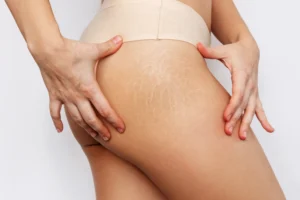 Stretch marks, or striae, are long, thin streaks or lines that appear on the skin when it stretches rapidly. They often occur due to changes in body size, such as during pregnancy, puberty, or significant weight fluctuations. Stretch marks can vary in color, starting as red, purple, or pink and gradually fading to a lighter, silvery hue. Stretch marks are commonly found on the abdomen, thighs, hips, buttocks, breasts, and arms. While they are harmless, many individuals seek treatment to reduce their visibility and improve the appearance of their skin.
Stretch marks, or striae, are long, thin streaks or lines that appear on the skin when it stretches rapidly. They often occur due to changes in body size, such as during pregnancy, puberty, or significant weight fluctuations. Stretch marks can vary in color, starting as red, purple, or pink and gradually fading to a lighter, silvery hue. Stretch marks are commonly found on the abdomen, thighs, hips, buttocks, breasts, and arms. While they are harmless, many individuals seek treatment to reduce their visibility and improve the appearance of their skin.
At Art of Skin Dermatology, Tania Cohen, DMSC, PA-C, provides professional treatments to help minimize the appearance of stretch marks. These treatments target the underlying skin structure and improve texture, tone, and smoothness.
HOW DO STRETCH MARK TREATMENTS WORK?
Stretch mark treatments encourage the skin’s natural healing processes and promote collagen production. The protein collagen gives skin its structure and elasticity, and treatments that stimulate collagen production can help fade stretch marks and improve skin texture over time.
There are several effective treatment options for stretch marks, including:
- Laser Therapy: Laser treatments target the deeper layers of the skin, promoting new collagen formation and improving skin elasticity. These lasers help reduce the visibility of stretch marks by breaking down the damaged tissue and encouraging the skin to repair itself. This process can soften the texture of stretch marks and help them blend more naturally with the surrounding skin.
- Microneedling: This procedure involves using tiny, tiny needles to create micro-injuries in the skin to stimulate the healing process. Over time, stretch marks fade as the skin heals, producing new collagen over time. As a minimally invasive treatment, microneedling is particularly effective for addressing older, more established stretch marks.
- Chemical Peels: A chemical peel works on the skin’s surface, encouraging cell turnover and improving skin texture. For stretch marks, a chemical peel can help reduce pigmentation and promote collagen production in the affected areas. This treatment is often combined with other methods for enhanced results.
- Radiofrequency (RF) Therapy: RF therapy uses energy waves as a means of stimulating collagen production in the deeper layers of the skin, improving skin firmness. Enhancing the skin’s overall texture and tightening the skin, this treatment can reduce the depth and visibility of stretch marks.
Each treatment is customized to the individual’s skin type, stretch mark severity, and desired outcome. Your provider will help you choose the best option based on your unique goals.
WHAT SHOULD I EXPECT DURING A STRETCH MARK TREATMENT SESSION?
A stretch mark treatment session begins with a skin assessment and aesthetic consultation. Your provider will evaluate the type and severity of your stretch marks and recommend the most suitable treatment for your needs.
The treatment procedure will vary depending on the method chosen. For laser therapy, a specialized laser device targets the stretch marks, while microneedling involves tiny needles to create microchannels in the skin. Both treatments typically last between 30 to 60 minutes, depending on the size of the area being treated. For most treatments, a topical numbing cream is applied beforehand to ensure comfort during the procedure.
Most stretch mark treatments require Little to no recovery time, although some patients may experience mild swelling, sensitivity, or redness. These side effects are common and subside within a few days.
WHAT SHOULD I EXPECT AFTER STRETCH MARK TREATMENT?
After a stretch mark treatment, the skin may feel slightly sensitive, and some redness or swelling may be present, especially after laser therapy or microneedling. The symptoms are usually mild and should disappear within a few days. Your provider will provide aftercare instructions, such as avoiding sun exposure and using a gentle moisturizer to promote healing.
Results from stretch mark treatments typically become noticeable over several weeks as the skin begins to heal and produce new collagen. With laser treatments or microneedling, multiple sessions may be needed to achieve optimal results, particularly for more severe or older stretch marks.
The final results include smoother skin, less visible stretch marks, and improved texture and tone. Regular maintenance sessions may be recommended depending on your skin type and the extent of the stretch marks.
